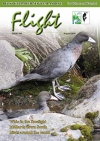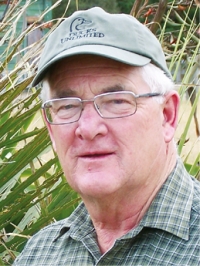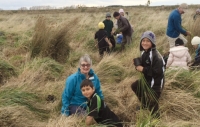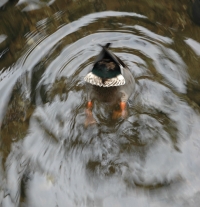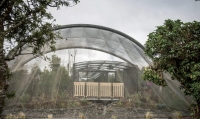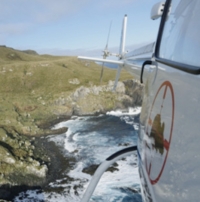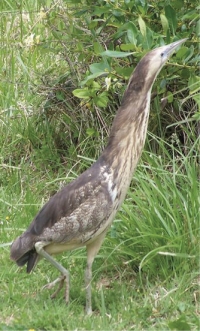I am sitting here at the computer looking out the window towards Lake Whatuma watching the rain continue to fall. We have had 30mm over the last 12 hours with more to come!! A real blessing as we in Hawke’s Bay, like many other regions, have experienced one of the driest autumns over the last…
Published in
Issue 168
Tagged under
Restoration Day at Wario May 21, proved to be a success with helpers like Ross Cottle, Ian Gunn, and Tapuwa Marapara, who were able to share their expertise with those who attended. Adding to the success was the wide diversity of people present, both as presenters and as participants. There were 30 on the bus…
Published in
Issue 168
Tagged under
June 21 work started at 9am for the organisers, supported by some strong lads from Taratahi Agricultural Training College and farm workers from a local sheep and beef station Palliser Ridge. Those strong farming trainees dug holes in pre-sprayed spots in rough, fescue infested terrain. Just after 10am we also had about 20 school children…
Conservation rates highly with DUNZ members, so it’s not surprising that one of our own received an award for commitment to the cause in this year’s Queen’s Birthday Honours list. Andrew (Andy) Graeme Lowe, of Havelock North, a long-time member of Ducks Unlimited, was made a member of the New Zealand Order of Merit (MNZM)…
Published in
Issue 168
Tagged under
There is an erratum that is worth mentioning – in regards to the shallow ponds being most used by broods. The shallow ponds are all less than 43cm deep. This is the depth that is recognised in literature as the maximum depth adult mallards can reach when tipping up to feed (Phillips 1923 & Olney…
Published in
Issue 168
Tagged under
Why are zero scores in tennis called ‘love’? BECAUSE: In France, where tennis became popular, the round zero on the scoreboard looked like an egg and was called ‘l’oeuf’, which is French for ‘the egg’. When tennis was introduced in the US, Americans (naturally), mispronounced it ‘love’ Why do X’s at the end of a…
At Pukaha Mt Bruce staff have been delighted with the way the birds have settled into their new home in the free flight aviary. The whio and pateke are loving their new areas and are not difficult to spot. The whio are in an ‘internal aviary’ with a new river run while the other birds…
Published in
Issue 168
Tagged under
The ambitious Million Dollar Mouse pest eradication project on remote Antipodes Island in the sub-antarctic was completed ahead of schedule in July. A second helicopter drop of rodent bait across the island was finished in July, following a first phase completed on June 29. “Despite very unsettled weather conditions, the Million Dollar Mouse team have…
Published in
Issue 168
Tagged under
With less than 3000 whio around New Zealand, they need all the help they can get. A two-day Whio Recovery Workshop was held in June at Tokaanu, near Turangi, where people with a passion for the endangered nativeblue duck gathered to hear information, ask questions and get what answers they could, although the overwhelming conclusion…
Published in
Issue 168
Tagged under
Keen for a bit of sport during duck hunting, Australian David McNabb checked in at Di Pritt’s (our co-patron’s) property to see what sport was on offer. Di’s two dogs Rommi and Luke were keen for some action but on the whole it seemed they were mostly just keeping an eye on proceedings at Swan…
Published in
Issue 168
Tagged under
A little old but of interest to those who care about Pateke. We will obviously have to extend our daytime surveys further up into the forest in future. I have seen Pateke way up on the open hills in pitch darkness probably 1km from their daytime roosts showing just how nocturnal they are. And Surprise,…
Ducks Unlimited NZ AGM (23 July 2016) Emma Williams has continued working on the bittern project assisted by me and other volunteers. Key points are: Emma graduated with her Doctorate Degree at Massey University which was based on bittern research. A huge thank you to DU for helping fund a major part of her work…
Published in
Issue 168
Tagged under
The white swan arrived in New Zealand in 1866. It is one of seven swan species found world–wide. It maintained a tenuous hold in the wild on various wetlands and some live in a semi–feral state in town parks. They once numbered several hundred in the wild but the 1968 the Waihine storm destroyed much…
Published in
Issue 168
Tagged under
During a historic visit to Wetlands International’s Head Office in the Netherlands on May 24, this year (2016), the State Forestry Administration (SFA) of the People’s Republic of China strengthened international collaboration for wetland conservation. The delegation was led by the State Forest Administration’s Vice-Minister, Mr Chen Fengxue. During the visit he signed a new…
At Mungalla Stud, a property of 880 hectares there are approximately 230 hectares of seasonally inundated wetlands which are adjacent to the World Heritage Great Barrier Reef and also the IUCN listed Halifax Bay Wetlands National Park. These wetland have been degraded by invasive plants as a result of installing an earth wall to halt…
Neil flies 450 km to Moodie Swamp;Robbie at Tootgarook?! The following piece was posted in late May this year 2016. Bittern watchers take note… As if Neil’s spectacular 450 km dispersal wasn’t enough, photos taken in May have watchers wondering which of their other bitterns are down near Melbourne. But first Neil. He left his…
Louisiana Wetlands:Recognising a National Treasure May 26, 2016 | Posted by Emily McCalla in coastal restoration, May is American Wetlands Month, and Louisiana’s coastal wetlands are some of the most productive ecosystems in North America. Not only do they provide habitat for numerous fish, wildlife and birds, but they also help improve water quality, provide…
Illegal killing, taking and trade of migratory birds Each year an estimated 50 billion migratory birds travel thousands of kilometers. On their migratory routes the birds have to overcome enormous obstacles. One is illegal killing. Many wild birds are illegally taken or killed due to hunting for subsistence, recreational activities and traditional practice. This year’s…
Employer: Victoria University of Wellington Location: Wellington, New Zealand Discipline: Ecology, Human and Physical Geography Position Type: Full Time Job Type: Postdoctoral Fellowship 3 year fixed term Salary: NZ$ 71,806 –82,500, depending on experience. Closes: 1 October 2016 Reference: 1142 Description of the project Wetlands for people and place. Wetlands are among the most valuable…
Published in
Issue 168
Tagged under

